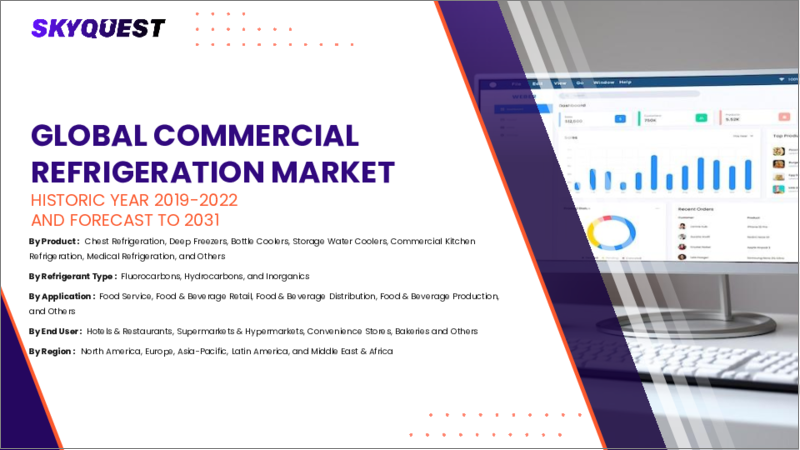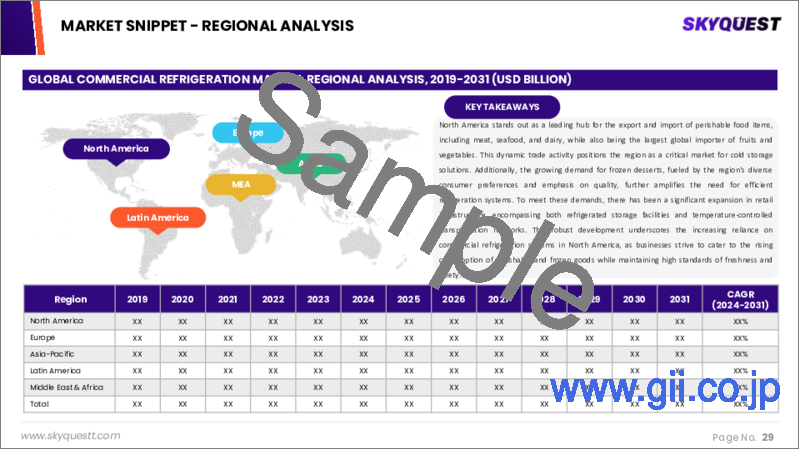|
|
市場調査レポート
商品コード
1603400
業務用冷蔵庫の市場規模、シェア、成長分析、製品タイプ別、システムタイプ別、冷媒別、流通チャネル別、地域別 - 産業予測、2024年~2031年Commercial Refrigeration Market Size, Share, Growth Analysis, By Product (Transportation Refrigeration Equipment, Refrigerators & Freezers), By System Type, By Refrigerant, By Distribution Channel, By Region - Industry Forecast 2024-2031 |
||||||
|
|||||||
| 業務用冷蔵庫の市場規模、シェア、成長分析、製品タイプ別、システムタイプ別、冷媒別、流通チャネル別、地域別 - 産業予測、2024年~2031年 |
|
出版日: 2024年11月26日
発行: SkyQuest
ページ情報: 英文 157 Pages
納期: 3~5営業日
|
全表示
- 概要
- 目次
業務用冷蔵庫の世界市場規模は2022年に440億米ドルと評価され、2023年の466億8,000万米ドルから2031年には732億8,000万米ドルに成長し、予測期間(2024-2031年)のCAGRは5.8%で成長する見通しです。
世界の業務用冷蔵庫市場は、飲食品、医薬品、ヘルスケアなど多様な分野における生鮮品の保存という不可欠なニーズに後押しされ、力強い成長を遂げています。世界貿易が拡大し、消費者の嗜好が生鮮品や冷凍品にシフトするにつれて、高度な温度制御ストレージ・ソリューションの需要が急増しています。都市化と人口増加は、食品廃棄物の最小化、食品の安全性の強化、生鮮品の賞味期限延長を目的とした信頼性の高い冷蔵システムの必要性をさらに高めています。この市場の主な促進要因には、飲食品セクターからの需要の増加、スーパーマーケットやハイパーマーケットの急増、ヘルスケア要件をサポートするためのコールドチェーン・ロジスティクスへの投資の強化などがあります。しかし、従来の冷凍システムによるエネルギー消費量の増加は大きな課題となっており、メーカー各社は持続可能でエネルギー効率の高い技術によるイノベーションを促しています。IoTやスマートセンサーの統合などの動向は、監視と最適化を合理化し、運用コストを効果的に削減します。環境に優しい冷媒への移行は、業界の持続可能性へのコミットメントを示しています。さらに、eコマース分野の急成長と医薬品におけるコールドチェーンロジスティクスの需要の高まりは、これらの市場に合わせた革新的な冷凍ソリューションに新たな機会をもたらしています。このようなダイナミックな状況により、メーカーやサプライヤーは、冷蔵倉庫やウォークインフリーザーのニーズの高まりに対応し、環境目標に沿いながら、世界化するサプライチェーンの進化する需要に確実に応えることができます。
目次
イントロダクション
- 調査の目的
- 調査範囲
- 定義
調査手法
- 情報調達
- 二次データと一次データの方法
- 市場規模予測
- 市場の前提条件と制限
エグゼクティブサマリー
- 世界市場の見通し
- 供給と需要の動向分析
- セグメント別機会分析
市場力学と見通し
- 市場概要
- 市場規模
- 市場力学
- 促進要因と機会
- 抑制要因と課題
- ポーター分析と影響
- 競争企業間の敵対関係
- 代替品の脅威
- 買い手の交渉力
- 新規参入業者の脅威
- 供給企業の交渉力
主な市場の考察
- 重要成功要因
- 競合の程度
- 主な投資機会
- 市場エコシステム
- 技術の進歩
- 規制情勢
- 特許分析
- バリューチェーン分析
- ケーススタディ分析
- 顧客と購買基準の分析
- PESTEL分析
- マクロ経済指標
- 市場の魅力指数
- 価格分析
業務用冷蔵庫の市場規模:製品別& CAGR(2024-2031)
- 市場概要
- 輸送用冷凍設備
- トレーラー
- トラック
- 配送
- 容器
- 冷蔵庫・冷凍庫
- ウォークイン冷蔵庫
- リーチイン冷蔵庫
- チェスト
- 飲料冷蔵
- ディスプレイショーケース
- アイスクリームキャビネット
- ベーカリー/デリディスプレイ
- その他
- 氷マーチャンダイザーと氷販売機器
- その他の機器
業務用冷蔵庫の市場規模:システムタイプ別& CAGR(2024-2031)
- 市場概要
- 自己完結型
- 遠隔操作
業務用冷蔵庫の市場規模:冷媒別& CAGR(2024-2031)
- 市場概要
- 合成冷媒
- HFC類
- HCFC
- 天然冷媒
- 二酸化炭素(CO2)
- アンモニア(NH3)
- その他
業務用冷蔵庫の市場規模:容量別& CAGR(2024-2031)
- 市場概要
- 50立方フィート未満
- 50~100立方フィート
- 100立方フィート以上
業務用冷蔵庫の市場規模:用途別& CAGR(2024-2031)
- 市場概要
- フードサービス
- 飲食品小売業
- ハイパーマーケット
- スーパーマーケット
- コンビニエンスストア
- 専門食料品店
- その他
- ホテルとホスピタリティ
- 医薬品
- ヘルスケア
- バイオテクノロジー
- 化学薬品
- その他
業務用冷蔵庫の市場規模:流通チャネル別& CAGR(2024-2031)
- 市場概要
- OEM(オリジナル機器製造会社)
- 販売業者および卸売業者
- 小売業者
業務用冷蔵庫の市場規模:地域別& CAGR(2024-2031)
- 北米
- 米国
- カナダ
- 欧州
- 英国
- ドイツ
- スペイン
- フランス
- イタリア
- その他欧州地域
- アジア太平洋
- 中国
- インド
- 日本
- 韓国
- その他アジア太平洋地域
- ラテンアメリカ
- ブラジル
- その他ラテンアメリカ地域
- 中東およびアフリカ
- GCC諸国
- 南アフリカ
- その他中東・アフリカ
競合情報
- 上位5社の比較
- 主要企業の市場ポジショニング(2023年)
- 主な市場企業が採用した戦略
- 市場の最近の動向
- 企業の市場シェア分析(2023年)
- 主要企業の企業プロファイル
- 会社概要
- 製品ポートフォリオ分析
- セグメント別シェア分析
- 収益の前年比比較(2021-2023)
主要企業プロファイル
- Carrier Global Corporation(US)
- Daikin Industries Ltd.(Japan)
- Emerson Electric Co.(US)
- Johnson Controls International plc(Ireland)
- Lennox International Inc.(US)
- Trane Technologies plc(Ireland)
- Hussmann Corporation(US)
- Dover Corporation(US)
- Frigoglass S.A.I.C.(Greece)
- Panasonic Corporation(Japan)
- Mitsubishi Electric Corporation(Japan)
- Haier Group Corporation(China)
- Bitzer Kuhlmaschinenbau GmbH(Germany)
- Danfoss A/S(Denmark)
- Liebherr Group(Switzerland)
- Hoshizaki Corporation(Japan)
- Metalfrio Solutions S.A.(Brazil)
- United Technologies Corporation(US)
- AHT Cooling Systems GmbH(Austria)
- Illinois Tool Works Inc.(US)
結論と推奨事項
Global Commercial Refrigeration Market size was valued at USD 44.0 billion in 2022 and is poised to grow from USD 46.68 billion in 2023 to USD 73.28 billion by 2031, growing at a CAGR of 5.8% during the forecast period (2024-2031).
The global commercial refrigeration market is witnessing robust growth, fueled by the essential need for preserving perishable goods across diverse sectors, including food and beverage, pharmaceuticals, and healthcare. As global trade expands and consumer preferences shift towards fresh and frozen products, the demand for advanced temperature-controlled storage solutions is surging. Urbanization and population growth further heighten the necessity for reliable refrigeration systems, aimed at minimizing food waste, bolstering food safety, and extending the shelf life of perishables. Key drivers of this market include the increasing demand from the food and beverage sector, the proliferation of supermarkets and hypermarkets, and enhanced investments in cold chain logistics to support healthcare requirements. However, rising energy consumption from conventional refrigeration systems poses significant challenges, prompting manufacturers to innovate with sustainable and energy-efficient technologies. Trends such as the integration of IoT and smart sensors streamline monitoring and optimization, effectively reducing operational costs. The transition to eco-friendly refrigerants demonstrates the industry's commitment to sustainability. Moreover, the rapid growth of the e-commerce sector and escalating demand for cold chain logistics in pharmaceuticals present new opportunities for innovative refrigeration solutions tailored to these markets. This dynamic landscape allows manufacturers and suppliers to capitalize on the increasing need for cold storage warehouses and walk-in freezers, ensuring they meet the evolving demands of a globalizing supply chain while aligning with environmental goals.
Top-down and bottom-up approaches were used to estimate and validate the size of the Global Commercial Refrigeration market and to estimate the size of various other dependent submarkets. The research methodology used to estimate the market size includes the following details: The key players in the market were identified through secondary research, and their market shares in the respective regions were determined through primary and secondary research. This entire procedure includes the study of the annual and financial reports of the top market players and extensive interviews for key insights from industry leaders such as CEOs, VPs, directors, and marketing executives. All percentage shares split, and breakdowns were determined using secondary sources and verified through Primary sources. All possible parameters that affect the markets covered in this research study have been accounted for, viewed in extensive detail, verified through primary research, and analyzed to get the final quantitative and qualitative data.
Global Commercial Refrigeration Market Segmental Analysis
Global Commercial Refrigeration Market is segmented by Product, System Type, Refrigerant, Capacity, Application, Distribution Channel and region. Based on Product, the market is segmented into Transportation Refrigeration Equipment, Refrigerators & Freezers, Beverage Refrigeration, Ice Merchandisers & Ice Vending Equipment, Other Equipment. Based on System Type, the market is segmented into Food Service, Food & Beverage Retail (Hypermarkets, Supermarkets, Convenience Store, Specialty Food Store, Others), Hotels and Hospitality, Pharmaceuticals, Healthcare, Biotechnology, Chemicals, Others. Based on Refrigerant, the market is segmented into Synthetic Refrigerants (HFCs, HCFCs), Natural Refrigerants (Carbon Dioxide (CO2), Ammonia (NH3), Others). Based on Capacity, the market is segmented into Less than 50 cu. Ft, 50 to 100 cu. Ft, more than 100 cu. Ft. Based on Application, the market is segmented into Food Service, Food & Beverage Retail (Hypermarkets, Supermarkets, Convenience Store, Specialty Food Store, Others), Hotels and Hospitality, Pharmaceuticals, Healthcare, Biotechnology, Chemicals, Others. Based on Distribution Channel, the market is segmented into OEMs (Original Equipment Manufacturers), Distributors and Wholesalers, Retailers. Based on region, the market is segmented into North America, Europe, Asia Pacific, Latin America and Middle East & and Africa.
Driver of the Global Commercial Refrigeration Market
The Global Commercial Refrigeration market is primarily driven by the burgeoning food and beverage sector, propelled by rising disposable incomes and evolving consumer lifestyles that favor processed and convenience foods. This trend necessitates advanced cold storage and refrigeration solutions. Particularly in emerging economies, the expansion of quick-service restaurants and supermarkets is significantly increasing the demand for commercial refrigeration equipment. Countries such as India and China are witnessing rapid growth in these sectors, further amplifying the need for refrigerators and freezers to effectively preserve perishable goods. Consequently, the interplay between industry growth and consumer preferences is a key market driver.
Restraints in the Global Commercial Refrigeration Market
The Global Commercial Refrigeration market faces significant restraints primarily due to environmental concerns and regulatory measures. The utilization of certain refrigerants, notably hydrofluorocarbons (HFCs), has been associated with detrimental environmental impacts, including climate change and ozone layer depletion. In light of these issues, numerous countries have begun enforcing regulations aimed at phasing out HFCs, promoting more sustainable refrigerant options such as hydrocarbons and natural alternatives. Nevertheless, the shift towards these eco-friendly refrigerants poses challenges for businesses, as it may necessitate modifications in existing equipment and could incur higher costs, complicating the transition.
Market Trends of the Global Commercial Refrigeration Market
The Global Commercial Refrigeration market is witnessing a significant trend towards smart refrigeration systems, propelled by advancements in Internet of Things (IoT) technology and smart sensors. These innovative solutions empower businesses to implement real-time monitoring and remote management of refrigeration units, enhancing operational efficiency and minimizing food spoilage. For instance, supermarkets are increasingly adopting smart refrigeration to receive immediate alerts on temperature changes, enabling timely interventions and significantly reducing waste. This growing adoption of smart technology not only promotes sustainability and cost-effectiveness but also aligns with consumer demands for superior food safety and quality, marking a pivotal shift in the commercial refrigeration landscape.
Table of Contents
Introduction
- Objectives of the Study
- Scope of the Report
- Definitions
Research Methodology
- Information Procurement
- Secondary & Primary Data Methods
- Market Size Estimation
- Market Assumptions & Limitations
Executive Summary
- Global Market Outlook
- Supply & Demand Trend Analysis
- Segmental Opportunity Analysis
Market Dynamics & Outlook
- Market Overview
- Market Size
- Market Dynamics
- Driver & Opportunities
- Restraints & Challenges
- Porters Analysis & Impact
- Competitive rivalry
- Threat of substitute
- Bargaining power of buyers
- Threat of new entrants
- Bargaining power of suppliers
Key Market Insights
- Key Success Factors
- Degree of Competition
- Top Investment Pockets
- Market Ecosystem
- Technological Advancement
- Regulatory Landscape
- Patent Analysis
- Value Chain Analysis
- Case Study Analysis
- Customer & Buying Criteria Analysis
- PESTEL Analysis
- Macro-Economic Indicators
- Market Attractiveness Index
- Pricing Analysis
Global Commercial Refrigeration Market Size by Product & CAGR (2024-2031)
- Market Overview
- Transportation Refrigeration Equipment
- Trailers
- Trucks
- Shipping
- Container
- Refrigerators & Freezers
- Walk-in-Refrigerators
- Reach-in Refrigerators
- Chest
- Beverage Refrigeration
- Display Showcases
- Ice Cream Cabinets
- Bakery/Deli Display
- Others
- Ice Merchandisers & Ice Vending Equipment
- Other Equipment
Global Commercial Refrigeration Market Size by System Type & CAGR (2024-2031)
- Market Overview
- Self-contained
- Remotely Operated
Global Commercial Refrigeration Market Size by Refrigerant & CAGR (2024-2031)
- Market Overview
- Synthetic Refrigerants
- HFCs
- HCFCs
- Natural Refrigerants
- Carbon Dioxide (CO2)
- Ammonia (NH3)
- Others
Global Commercial Refrigeration Market Size by Capacity & CAGR (2024-2031)
- Market Overview
- Less than 50 cu. Ft
- 50 to 100 cu. Ft
- more than 100 cu. Ft
Global Commercial Refrigeration Market Size by Application & CAGR (2024-2031)
- Market Overview
- Food Service
- Food & Beverage Retail
- Hypermarkets
- Supermarkets
- Convenience Store
- Specialty Food Store
- Others
- Hotels and Hospitality
- Pharmaceuticals
- Healthcare
- Biotechnology
- Chemicals
- Others
Global Commercial Refrigeration Market Size by Distribution Channel & CAGR (2024-2031)
- Market Overview
- OEMs (Original Equipment Manufacturers)
- Distributors and Wholesalers
- Retailers
Global Commercial Refrigeration Market Size & CAGR (2024-2031)
- North America, (Product, System Type, Refrigerant, Capacity, Application, Distribution Channel)
- US
- Canada
- Europe, (Product, System Type, Refrigerant, Capacity, Application, Distribution Channel)
- UK
- Germany
- Spain
- France
- Italy
- Rest of Europe
- Asia-Pacific, (Product, System Type, Refrigerant, Capacity, Application, Distribution Channel)
- China
- India
- Japan
- South Korea
- Rest of Asia Pacific
- Latin America, (Product, System Type, Refrigerant, Capacity, Application, Distribution Channel)
- Brazil
- Rest of Latin America
- Middle East & Africa, (Product, System Type, Refrigerant, Capacity, Application, Distribution Channel)
- GCC Countries
- South Africa
- Rest of Middle East & Africa
Competitive Intelligence
- Top 5 Player Comparison
- Market Positioning of Key Players, 2023
- Strategies Adopted by Key Market Players
- Recent Developments in the Market
- Company Market Share Analysis, 2023
- Company Profiles of All Key Players
- Company Details
- Product Portfolio Analysis
- Company's Segmental Share Analysis
- Revenue Y-O-Y Comparison (2021-2023)
Key Company Profiles
- Carrier Global Corporation (US)
- Company Overview
- Business Segment Overview
- Financial Updates
- Key Developments
- Daikin Industries Ltd. (Japan)
- Company Overview
- Business Segment Overview
- Financial Updates
- Key Developments
- Emerson Electric Co. (US)
- Company Overview
- Business Segment Overview
- Financial Updates
- Key Developments
- Johnson Controls International plc (Ireland)
- Company Overview
- Business Segment Overview
- Financial Updates
- Key Developments
- Lennox International Inc. (US)
- Company Overview
- Business Segment Overview
- Financial Updates
- Key Developments
- Trane Technologies plc (Ireland)
- Company Overview
- Business Segment Overview
- Financial Updates
- Key Developments
- Hussmann Corporation (US)
- Company Overview
- Business Segment Overview
- Financial Updates
- Key Developments
- Dover Corporation (US)
- Company Overview
- Business Segment Overview
- Financial Updates
- Key Developments
- Frigoglass S.A.I.C. (Greece)
- Company Overview
- Business Segment Overview
- Financial Updates
- Key Developments
- Panasonic Corporation (Japan)
- Company Overview
- Business Segment Overview
- Financial Updates
- Key Developments
- Mitsubishi Electric Corporation (Japan)
- Company Overview
- Business Segment Overview
- Financial Updates
- Key Developments
- Haier Group Corporation (China)
- Company Overview
- Business Segment Overview
- Financial Updates
- Key Developments
- Bitzer Kuhlmaschinenbau GmbH (Germany)
- Company Overview
- Business Segment Overview
- Financial Updates
- Key Developments
- Danfoss A/S (Denmark)
- Company Overview
- Business Segment Overview
- Financial Updates
- Key Developments
- Liebherr Group (Switzerland)
- Company Overview
- Business Segment Overview
- Financial Updates
- Key Developments
- Hoshizaki Corporation (Japan)
- Company Overview
- Business Segment Overview
- Financial Updates
- Key Developments
- Metalfrio Solutions S.A. (Brazil)
- Company Overview
- Business Segment Overview
- Financial Updates
- Key Developments
- United Technologies Corporation (US)
- Company Overview
- Business Segment Overview
- Financial Updates
- Key Developments
- AHT Cooling Systems GmbH (Austria)
- Company Overview
- Business Segment Overview
- Financial Updates
- Key Developments
- Illinois Tool Works Inc. (US)
- Company Overview
- Business Segment Overview
- Financial Updates
- Key Developments






